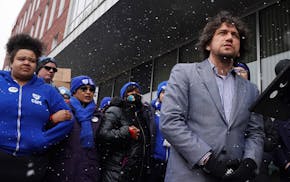There aren't enough hockey rinks in Edina.
Or at least, that's the case the city is making to persuade voters to extend a sales tax that would pay for another sheet at Braemar Arena, plus 100 new parking spots.
Edina Parks and Recreation Director Perry Vetter made the pitch on live-streamed video last week: More ice could mean less out-of-town practice for Edina youth hockey players, and more revenue for the arena.
Edina is one of 37 cities in Minnesota looking to sales taxes to fund their wish lists — and deploying city staff and resources to explain to voters what exactly they would be getting in exchange for their approval. More than a dozen such requests will be on local ballots this fall, with the rest expected to go before voters in 2024.
Under branded campaigns like "Renew Rochester," "Edina at Play" and "Bloomington Forward," city communications staff are rolling out websites, videos and newsletters, and dispatching other staff to public meetings and events to talk about all the goodies voters could get by approving sales taxes.
None of this is unprecedented, but after the Legislature approved a record number of sales tax proposals in 2023, voters across the state will be bombarded with messages from local officials about what a sales tax could pay for in their community.
Maple Grove spent about $40,000 in 2022 on a similar marketing effort for a half-cent sales tax meant to bring in $90 million to fund a new community center.
City Administrator Heidi Nelson said she thought it was worth the expense for residents to understand what they would be voting for and what they would be getting with a higher sales tax. Explaining the benefits alongside the obvious costs of raising taxes seemed important amid economic uncertainty.
"We were going to the voters with this local-option sales tax question at a time of high inflation," Nelson said. "We really felt our role was to make sure voters are informed when they're going to the polls."
Bloomington has spent about $45,000 on a website and the services of a communications consultant — the "Bloomington Forward" campaign would have been too much work for city staff, city communications director Janine Hill said. City workers have staffed booths at local farmers' markets, and the city has pushed out information in its newsletter, social media channels and with online videos and the dedicated website.
There are tricky lines for cities to navigate as they endeavor to educate voters, because city staff are not supposed to directly advocate for or against policies.
"We are constantly reaffirming we are not advocating for this," Hill said. "We are very careful about language that we're using."
In St. Paul, an outside advocacy group, Vote Yes for St. Paul, has formed to push for the sales tax, under the leadership of former City Council President and Public Works Director Kathy Lantry.
"It is a fine line," Lantry said of the divide between education and outright advocacy. "In my mind, what we'll be talking about is not what will be done, but why we need to do it and why we need to do it with a sales tax."
The St. Paul Area Chamber of Commerce has come out against the effort to pass a sales tax to rebuild major local streets.
Amanda Duerr, the chamber's vice president of government affairs, said the chamber understands that St. Paul's streets have suffered from years of disinvestment and that the city has real challenges when it comes to raising revenue through property taxes. But chamber members worry a higher city sales tax will push customers to the suburbs.
The relationship between residents of a city and people who just shop there has been a key point in many cities' education campaigns.
Many cities and counties have engaged Bruce Schwartau, leader of the community economics program at University of Minnesota Extension, to estimate how much of a local sales tax would be paid by non-residents.
Schwartau said he has worked with about 30 cities and counties that have looked for estimates of how the burden of a sales tax would fall on residents and nonresidents. The splits can vary widely, he said, depending on how many visitors and non-local shoppers a city gets.
In Edina, for example, Vetter said the estimate was that non-Edinans would shoulder about 54% of the cost to expand Braemar Arena by paying $17.1 million in sales taxes over the next 19 years.
City education efforts and sales tax advocates are both underlining the idea of divvying up the cost of projects beyond residents of one city.
Lantry compared the idea of a sales tax to dining out with friends. Sure, she said, you could pay for everyone's meal. But wouldn't it make more sense to split the bill?
"For me it's an easy argument to make, because we have people who come to our city all the time and don't contribute to the maintenance and reconstruction of our streets," Lantry said. "You get the people who are using the service to assist in paying for it."
Star Tribune staff writers Katie Galioto and Trey Mewes contributed to this story.

Lakewood Cemetery in Minneapolis opens new Welcome Center
Man killed in domestic incident in Coon Rapids, Sheriff's Office says

U of M's interim president meets with pro-Palestinian protest leaders

Legendary boys hockey coach Randolph loses his job

